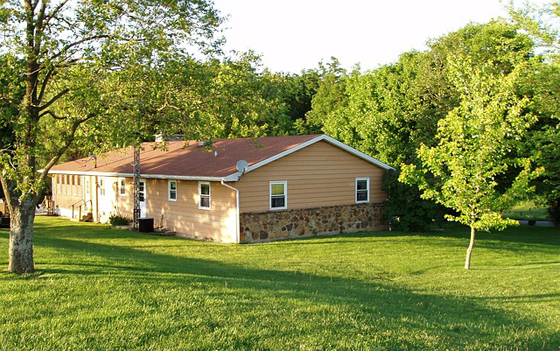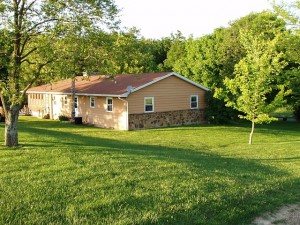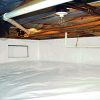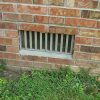Most of you know that evaporation of moisture from your skin makes you feel cooler. That’s because evaporation takes heat energy, thereby cooling the air wherever it takes place. Turn on a sprinkler on a hot day and the area surrounding it will feel cooler.
Trees act as gigantic sprinklers as their leaves transpire (release water vapor). When that moisture evaporates, the air around the tree is cooled. If your home is close by, you benefit with greater comfort and lowered cooling costs. In addition, trees with large crowns (leafy branched out areas) can block solar radiation from overheating your siding and roof and from entering your home through windows and patio doors. The Department of Energy estimates that a few well-placed shade trees can reduce average household cooling costs between $100 and $250 annually.
For this cooling strategy to work, however, the canopy of your shade trees should be expected to grow tall enough shade your roof as the sun climbs the southern sky. In general, the trees do not need to be as tall to the east and west where the sun is lower in the sky. Ideally, shade trees should have few lower branches and foliage that might otherwise block cooling summer breezes. Plant deciduous trees so that the sun can reach your home in winter, after the leaves have fallen and when solar thermal gain can lower your heating costs.
Trees with large crowns (leafy branched out areas) can block solar radiation from overheating your siding and roof and from entering your home through windows and patio doors. The Department of Energy estimates that a few well-placed shade trees can reduce average household cooling costs between $100 and $250 annually.
A good source of information about shade trees that thrive in your region is the nearest U.S. Department of Agriculture Cooperative Extension Service (CES). Most states have them. Extension centers are typically located throughout the state. Find the one nearest you and contact it for shade tree recommendations in your locale.
According to the University of Missouri Extension, shade tree species should be judged according to:
- Maximum mature height
- Tree canopy shape and leaf density
- Growth rate
- Insect pest resistance
- Disease resistance
- Ability to withstand high winds
- Ability to grow in less than ideal soils, including poor drainage
- Ease of transplanting
If you live in a city, the tree must be able to withstand car pollution and run-off after de-icing roads. If you live in a hot, dry climate, it must be able to growth with minimal rainfall.
The University of Missouri Extension recommends buying a high quality, 8 to 10-ft. tall tree that’s either balled and wrapped with burlap or growing in a container. Its recommended list of shade trees is applicable for much of the U.S.
If solar energy is in your future…
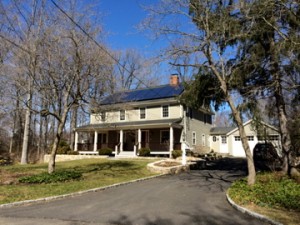
Trees are wonderful for cooling a home but not so great if you plan on installing a solar electric system. Ornamental trees in this yard do not pose a threat, but the large trees to the east and west diminish electricity production in the morning and late afternoon.
If you are planning to install solar electric (photovoltaic) modules, you won’t want trees shading your roof (the ideal location for PV panels). Even small areas of shade can significantly reduce your electricity production—not something you want to do after spending all that money on your system. If your shade trees are already in place and established, and you’d like to generate electricity with the sun, consider mounting the modules on a rack or on poles in a sunny part of your yard. The racks and poles will add to your the cost of your system but won’t have to be removed when it’s time to re-roof your home.
Solar thermal systems, such as water heating systems, suffer from tree shade as well. Even in winter with leaves off the trees, shade from branches and twigs can reduce solar system efficiencies by 30 to 60 percent.
Other energy-saving landscaping ideas
Another landscaping idea for saving energy is to plant dense evergreen shrubs around your foundation. They create a “dead air space,” not unlike the dead air space between the panes of glass in an insulated window, or between a window and heavy drapery. The air space will help insulate your home by slowing heat loss. Keep shrubbery at least 4 ft. from the house so that you can access siding and gutters for maintenance. Do not allow shrubs to get too tall along the southeast, south, and southwest sides of the home if there are windows. Once again, you don’t want to block solar gain in winter.
A bigger landscaping project, but one that can make a big difference in your heating bill, is to plant a windbreak. Look up the mature height of the tree species you select and multiply by 2. This is the minimum distance the trees should be planted from the house. Multiply the mature height by 5 to get the maximum planting distance from the house. For example, a red maple that’s expected to grow to 50 feet should be planted at least 100 but no more than 250 ft. Typically the best place to plant a windbreak is to the north and northwest.
Before you buy a tree or beginning digging, consult with a landscape designer to avoid costly mistakes. Many work for local nurseries and are there to help. Also check with utilities to be certain you are not digging in the path of pipes or cables. Finally, remember that in addition to reducing cooling costs, trees and shrubs add beauty and grace to your property. They increase property value as well.

